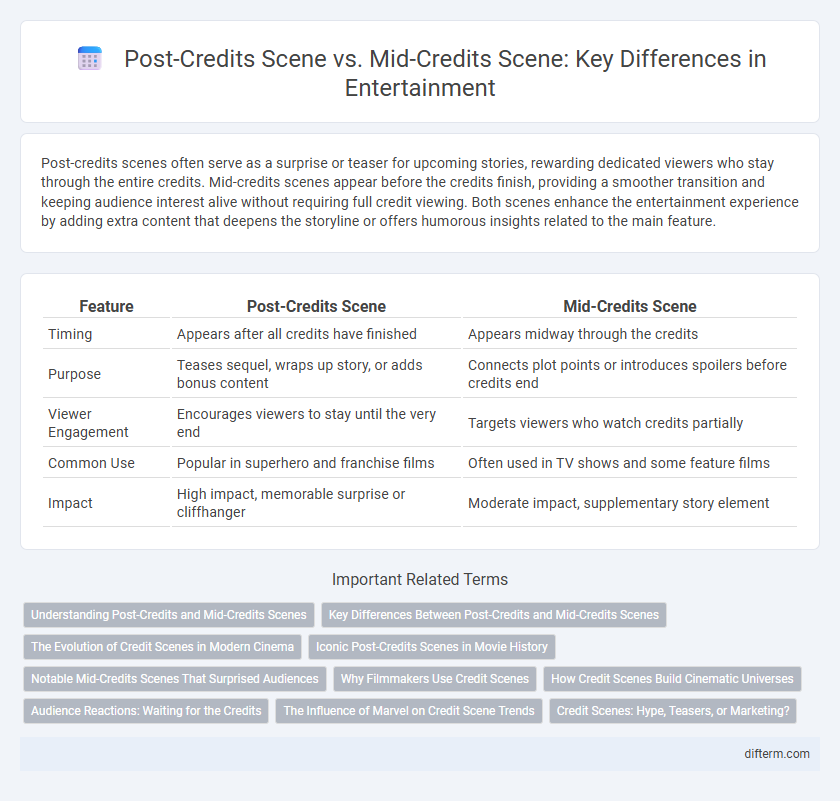Post-credits scenes often serve as a surprise or teaser for upcoming stories, rewarding dedicated viewers who stay through the entire credits. Mid-credits scenes appear before the credits finish, providing a smoother transition and keeping audience interest alive without requiring full credit viewing. Both scenes enhance the entertainment experience by adding extra content that deepens the storyline or offers humorous insights related to the main feature.
Table of Comparison
| Feature | Post-Credits Scene | Mid-Credits Scene |
|---|---|---|
| Timing | Appears after all credits have finished | Appears midway through the credits |
| Purpose | Teases sequel, wraps up story, or adds bonus content | Connects plot points or introduces spoilers before credits end |
| Viewer Engagement | Encourages viewers to stay until the very end | Targets viewers who watch credits partially |
| Common Use | Popular in superhero and franchise films | Often used in TV shows and some feature films |
| Impact | High impact, memorable surprise or cliffhanger | Moderate impact, supplementary story element |
Understanding Post-Credits and Mid-Credits Scenes
Post-credits scenes are brief clips shown after all the credits have finished rolling, often serving as teasers for future storylines or additional character insights. Mid-credits scenes appear halfway through the credit sequence, providing key plot details or setting up sequels without requiring viewers to stay until the very end. Understanding the strategic placement of these scenes enhances audience engagement and anticipation in film and television entertainment.
Key Differences Between Post-Credits and Mid-Credits Scenes
Post-credits scenes appear after all the credits have finished rolling, serving as a final surprise or teaser, while mid-credits scenes occur in the middle of the credits sequence, designed to retain viewers during the initial part of the credits. Mid-credits scenes often set up upcoming plot points or character arcs, maintaining engagement before the film fully concludes. Post-credits scenes typically provide a conclusive or bonus narrative element, contributing to the overall storytelling experience in entertainment franchises.
The Evolution of Credit Scenes in Modern Cinema
Post-credits scenes have evolved from rare Easter eggs to integral narrative tools in modern cinema, especially within the Marvel Cinematic Universe, where they hint at future installments and expand storylines. Mid-credits scenes, positioned at the halfway mark of the credits, maintain audience engagement by revealing plot twists or character cameos without requiring a full wait, blending storytelling with pacing innovation. This evolution reflects studios' strategic use of credit scenes to enhance viewer retention, build cinematic universes, and deepen fan investment in franchises.
Iconic Post-Credits Scenes in Movie History
Iconic post-credits scenes have become a staple in blockbuster films, often serving as pivotal moments that tease future storylines or provide unexpected humor. Unlike mid-credits scenes, which appear halfway through the credits and sometimes risk being missed by casual viewers, post-credits scenes reward dedicated audiences who stay until the very end. The Marvel Cinematic Universe, with memorable scenes like the reveal of Thanos in "The Avengers" and Nick Fury's call in "Iron Man," has cemented the post-credits scene as a powerful tool for building anticipation and expanding cinematic universes.
Notable Mid-Credits Scenes That Surprised Audiences
Certain mid-credits scenes in blockbuster franchises have notably surprised audiences by teasing critical plot developments or new characters, such as the revelation of Thanos in "The Avengers" (2012) that set the stage for the Marvel Cinematic Universe's Infinity Saga. These mid-credits scenes often serve as pivotal storytelling tools, differentiating themselves from post-credits scenes by appearing earlier and maintaining audience engagement before full credits roll. Films like "Guardians of the Galaxy" also use mid-credits moments to introduce unexpected plot twists or humorous callbacks, enhancing the viewing experience and expanding the cinematic universe.
Why Filmmakers Use Credit Scenes
Credit scenes, whether mid-credits or post-credits, serve as strategic tools for filmmakers to deepen audience engagement and expand the narrative universe. These scenes often reveal pivotal plot twists, set up future installments, or provide closure for secondary storylines, thereby enhancing the overall storytelling experience. By leveraging credit scenes, creators sustain viewer interest beyond the main feature, fostering anticipation and loyalty toward the franchise.
How Credit Scenes Build Cinematic Universes
Post-credits and mid-credits scenes serve as strategic tools to expand cinematic universes by introducing new characters, teasing future plotlines, and creating narrative continuity across films. These scenes deepen audience engagement by linking standalone stories to a larger, interconnected franchise, as seen in Marvel Studios' use of mid-credits scenes to set up sequels and spin-offs. By rewarding viewers who stay through the credits, filmmakers foster anticipation and sustained interest, effectively turning isolated movies into expansive, cohesive storytelling experiences.
Audience Reactions: Waiting for the Credits
Post-credits scenes often create heightened audience anticipation, motivating viewers to stay seated through the entire credits to catch hidden content or teasers for upcoming installments. Mid-credits scenes tend to trigger a mix of excitement and impatience, as some viewers wait eagerly while others opt to leave early, potentially missing key narrative elements. Audience reactions vary widely, with social media buzz amplifying the impact of both scene types on fan engagement and discussion.
The Influence of Marvel on Credit Scene Trends
Marvel Studios revolutionized film post-credits and mid-credits scenes, turning them into essential elements that heighten audience anticipation for future installments. Their strategic placement of surprise reveals and teasers during these scenes has influenced other studios to adopt similar tactics, boosting viewer engagement and franchise loyalty. This trend has transformed credit scenes from mere closures into pivotal storytelling devices, shaping modern cinematic universe-building.
Credit Scenes: Hype, Teasers, or Marketing?
Post-credits scenes captivate audiences by offering exclusive content that teases upcoming plotlines or spin-offs, driving anticipation and engagement beyond the main feature. Mid-credits scenes maintain viewer interest during the credits, strategically placed to reward loyal fans while encouraging sustained attention and social media buzz. Both formats serve as powerful marketing tools, amplifying hype and extending the entertainment experience to fuel franchise growth and audience retention.
post-credits scene vs mid-credits scene Infographic

 difterm.com
difterm.com